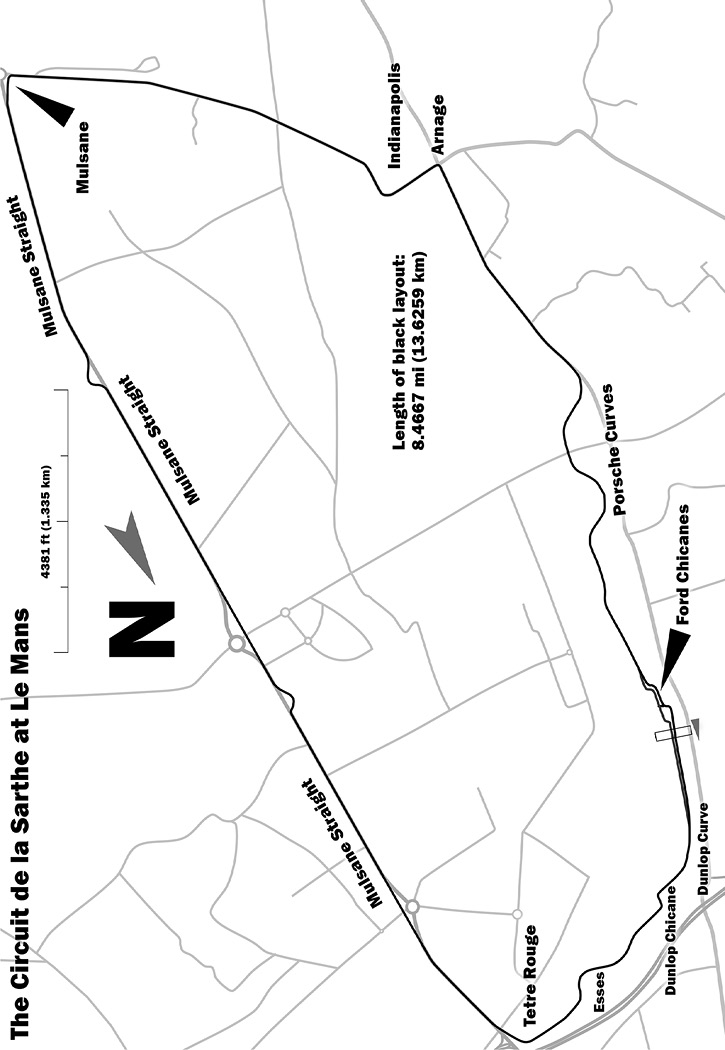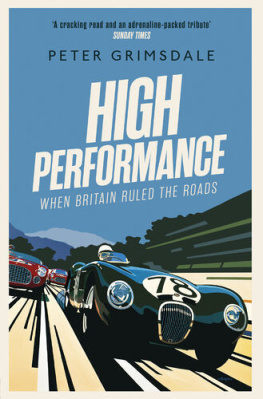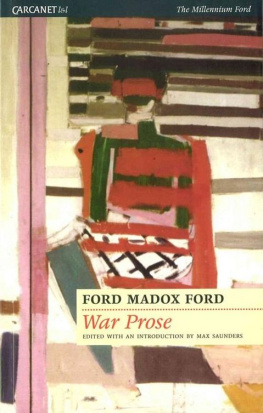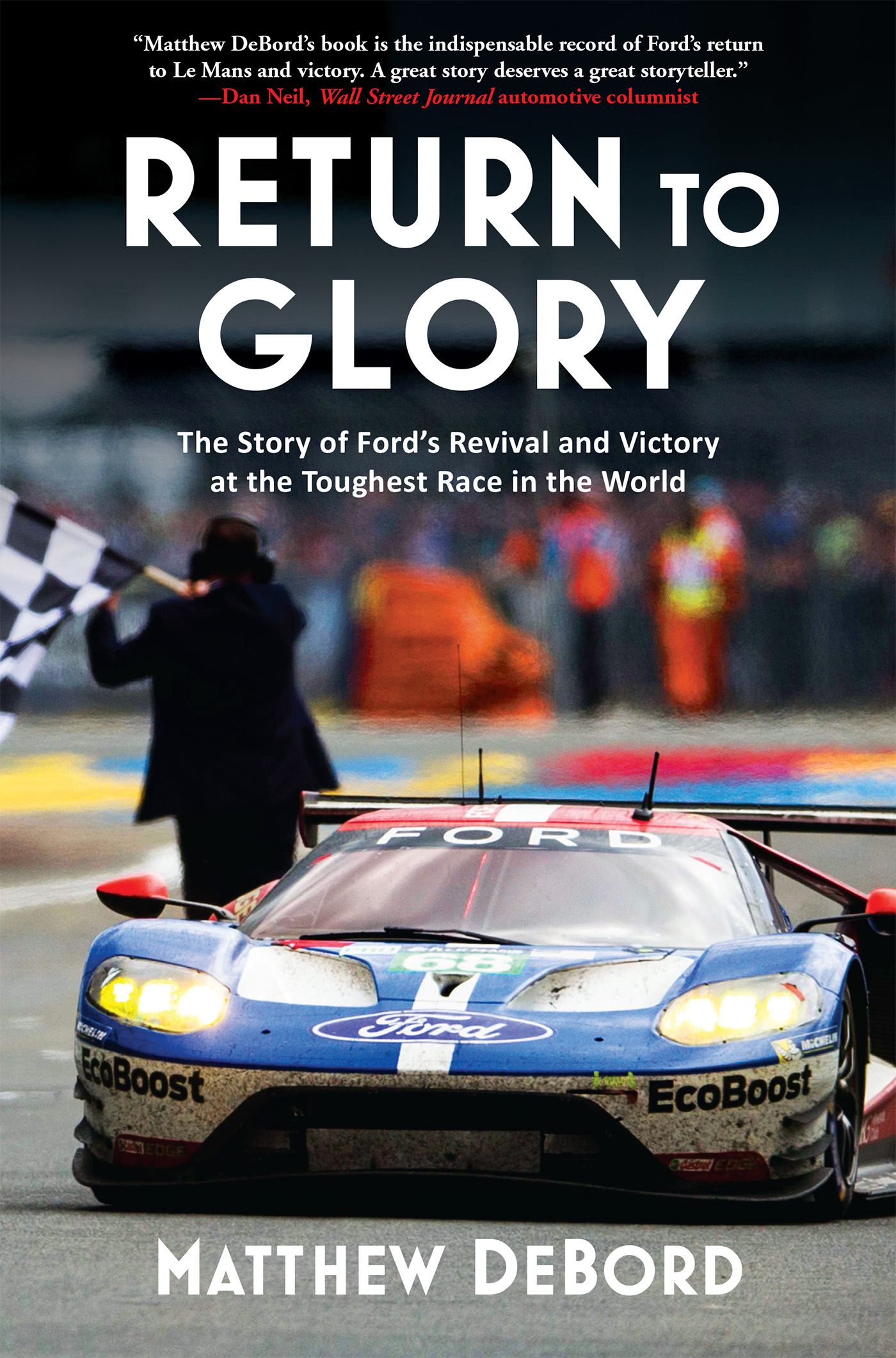RETURN
TO GLORY
Also by Matthew DeBord
Wine Country USA:
Touring, Tasting, and Buying at
Americas Regional Wineries
The New York Book of Wine:
A City and Company Guide
RETURN
TO GLORY
The Story of Fords Revival and Victory
at the Toughest Race in the World
Matthew DeBord

Atlantic Monthly Presss
New York
Copyright 2017 by Matthew DeBord
Jacket design by Michael Patrick Dudding
Jacket photograph reproduced with the kind permission of the Ford Motor Company
Circuit de la Sarthe map 2010 Will Pittenger; wlps-ge-stuff.ucoz.com
Images on pp. 15 and 6 (top right, bottom) courtesy of Ford Images; p. 6 (top left) courtesy of Wikimedia Commons ; pp. 711, 12 (top), and 1416 courtesy of Ford Motor Company; p. 12 (bottom) Regis Lefebure; p. 13 courtesy of Ferrari S.p.A.
All rights reserved. No part of this book may be reproduced in any form or by any electronic or mechanical means, including information storage and retrieval systems, without permission in writing from the publisher, except by a reviewer, who may quote brief passages in a review. Scanning, uploading, and electronic distribution of this book or the facilitation of such without the permission of the publisher is prohibited. Please purchase only authorized electronic editions, and do not participate in or encourage electronic piracy of copyrighted materials. Your support of the authors rights is appreciated. Any member of educational institutions wishing to photocopy part or all of the work for classroom use, or anthology, should send inquiries to Grove Atlantic, 154 West 14th Street, New York, NY 10011 or .
First Grove Atlantic hardcover edition: June 2017
Published simultaneously in Canada
Printed in the United States of America
ISBN 978-0-8021-2650-4
eISBN 978-0-8021-8955-4
Library of Congress Cataloging-in-Publication data is available for this title.
Atlantic Monthly Press
an imprint of Grove Atlantic
154 West 14th Street
New York, NY 10011
Distributed by Publishers Group West
groveatlantic.com
For August, Mario James, and Dante
and for Detroit
Contents
THIS COULD ALL GO AWAY
Betting the Farm
One Ford
Behold the New GT
Disaster at Daytona
ALL RIGHT, WELL BEAT HIS ASS
Chapter 5: Ford Would Like to Buy Ferrari
No Tougher Test
The GT40
One-Two-Three
WERE GOING TO WIN FROM THE LEAD
The Tesla Factor
The Road to Le Mans: Sebring and Long Beach
Silverstone, Laguna Seca, and Spa
You Want to Win the Big Ones
Were Going to Win from the Lead
Fifty Years to the Day

Prologue
June 19, 2016
It was morning in Le Mans, 130 miles southwest of Paris.
The preceding night had been pierced by the screams and howls of powerful race cars as they covered, endlessly it seemed, an eight-and-a-half-mile circuit first laid out in the early 1920s, when a race car was lucky to threaten 100 miles per hour. As French family dinners proceeded in tents and impromptu fireworks displays lit up the skies over the countryside, the engines wails had continued. Theyd raged on as bedraggled fans from all over the world grabbed a few hours of sleep in cars, campers, and tents strewn around grassy parking lots and fields.
In the cockpit of his Ford GT, the supercar Ford had built to commemorate its legendary win at the 1966 24 Hours of Le Manswith, the plan was, a fresh winJoey Hand had been pushing 200 miles per hour since sunrise. So far his average speed in the twin-turbocharged, 600-horsepower, low-slung race car was 150 miles per hour. He was sweating under his helmet, and inside his fireproof racing suit. He had shifted gears hundreds of times. He was thirsty, and he was getting tired.
The nighttime run hadnt worked out entirely in Fords favor. There was a Ferrari in the mix. It was the number 82 car, a so-called privateer ride supported by Risi Competizione of Houston, Texas. Hand, a compulsively cheerful Californian in his mid-thirties, who had a taste for American flagmotif cowboy hats and McDonalds breakfastsIve won a lot of races with sausage Egg McMuffin in my stomach, he liked to saywas in the number 68 Ford GT, possibly the most anticipated high-performance machine in recent history. It had been designed from the ground up to win endurance races, Le Mans in particular.
The new GT had first rolled a wheel, in racing parlance, fewer than 400 days earlier. There were now four GTs on the Circuit de la Sarthe at Le Mans, all red-white-and-blue and numbered 66, 67, 68, and 69the years of Fords Le Mans victories with the cars ancestor, the immortal GT40. And as the mid-morning snack lines formed outside the crpe truck parked 100 yards from the pits, where the race cars pulled in for fuel and tire changes, Hands GT was in second place.
One or another of the GTs had run in first place plenty during the event, which extended from the afternoon of June 18 to the afternoon of June 19an entire solar day of racing, designed to break cars, to break drivers, and to break whole companies. When Ford had won this thing in epic fashion on the same weekend fifty years earlier, it had crushed Ferrari, the team that had dominated Le Mans from 1960 to 1965 with its seductive red track rockets fueled by the ego of Enzo Ferrari.
Now Hand was running down the latter-day version of those same red Ferraris Ford had beaten in 66. At the wheel of the Ferrari 488 GTE, a gorgeous twin-turbo, V-8powered wedge of the finest Italian engineering and design, was Matteo Malucelli, a swashbuckling thirty-one-year-old from Forl, near Bologna, who had survived a devastating crash two years earlier.
This was the GTE Pro class of the World Endurance Championship. This was the 24 Hours of Le Mans, perhaps the most famous race in the world and easily the toughest, a brutal test of driver and machine.
Hand and Malucelli were racing and racing hard.
The pouring rains that had beset the previous afternoons start were long gone. With the sun rising in the sky, Hand sensed his moment. The setup was perfect. He was right on Malucellis bumperor, more accurately, his carbon-fiber diffuser, an aerodynamic component that extended low from the Ferraris rear. Because Hands car had been the fastest in qualifying, and fast enough to win the pole position, he knew he had the speed for a pass. He just had to pick his spot, find his momentand not do something stupid, like overplay his chance and wreck the car.
He had Ferrari red in front of him, but a growling Ford EcoBoost V-6 engine was behind him, pumping velocity to his rear wheels as violently as a fire hose pumping water. Hand had to hold his GT back just enough to have the extra punch when he needed it.
Malucelli wasnt on Hands mind anymore. Hand had chased him for enough laps to gather the information he needed to do what hed come to do, all the way from Sacramento, California, to this normally quiet but now raucous corner of France. Every year they hold this mad race and invite the best drivers and the finest cars in the world to destroy themselvesand the maddest part was coming up.
Its called the Mulsanne StraightLes Hunaudires in Frencha 3.7-mile stretch of tree-lined public road, where the fastest Le Mans racers, in the so-called prototype cars, can hit 250 miles per hour.
The Mulsanne Straight was the longest legal drag strip in the world, at least for this weekend. This was where Joey Hand was going to make his move. At 10:30 a.m., he peered through the eye port of his racing helmet and shifted in his racing suit. He remembered what Dave Pericak, the Ford executive heading up the Le Mans campaign, had said to him right before he got in the car: Joey, go get em.











